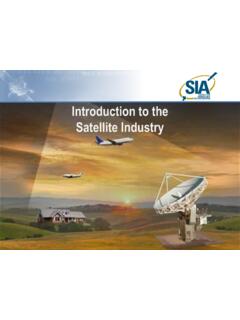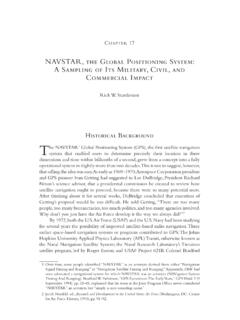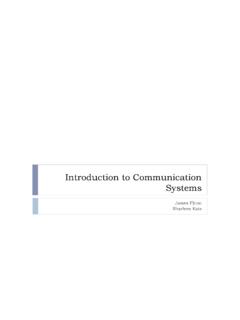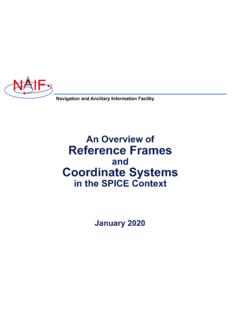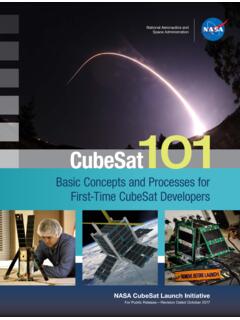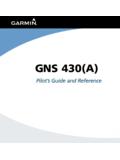Transcription of Basics of Satellite Communications - ITSO
1 Basics of Satellite Communications (Duration: 90 Minutes)Presenter:E. KasuleMusisiITSO ConsultantEmail: +256 772 783 784 Skype: ekasuleNote: Please ask Questions Anytime!Topics in this Module Birth of Satellite Communications Communication Links The Space Segment Satellite Design The Ground Segment Satellite Orbits Earth Station Registration Orbital Positions and Radio Interference Services Satellite Lifecycle Management Technology Trends Polarisation Introduction to Satellite Link AnalysisBirth of Satellite Communications 1/11 Communications satellites may be used for many applications: relaying telephone calls providing Communications to remote areas of the Earth, TV direct-to-user broadcasting providing Communications to ships, aircraft and other mobile vehicles etc .Network ServicesMedia ServicesGovernment ServicesISRM ilitary MobilityHosted PayloadsEnd-to-End CommunicationsEmbassy NetworksSpace Situational AwarenessDTHC ableDistributionMCPC PlatformsSpecial EventsSatellite News GatheringMobile VideoCell BackhaulMaritime CommunicationsOil & GasAeronauticalDisaster RecoveryEnterpriseBirth of Satellite Communications 2/11A Communications satelliteactsas a repeaterBirth of Satellite Communications 3/11 Frequently Asked Questions (FAQs) Who invented satellites?
2 Arthur C. Clarke, who went on to be a well-read author of science fiction novels. When were satellites invented? The first satellites were experimented with in the late 1950 s and early 1960 s. Intelsat s first Satellite , which was called Early Bird , was launched on 6 April 1965. How big is a Satellite ? (Based on the Intelsat 9 series) Before liftoff it s, about 4,500 kilograms! Without fuel, it s about 2,000 kilograms! The body is meters ..and the solar panels are 31 meters wide more than a 10-story building! How many years can a Satellite last? It varies by Satellite type. The type of satellites owned by Intelsat can last over 20 years, but typically their work life is approximately 15 of Satellite Communications 4/11 Frequently Asked Questions : How do you fix satellites if they get broken?
3 The satellites send back health check information to ground engineers all the time. Pre-developed commands are sent to the Satellite to perform certain functions, such as firing a booster or changing the angle of a solar panel, so that it can repair itself. How does a Satellite get its power? Mostly solar power collected by the solar are also batteries on the satellites for the times when the Satellite passes through the earths is called eclipse. How much power does it take to transmit a signal? The power used to send a Communications signal to the Earth from a Satellite is about the same as a typical 60W light bulb, just like you have at home. What kinds of people work in the Satellite industry? All kinds!Engineers, rocket scientists, sales people, writers, accountants and of Satellite Communications 5/11In the context of spaceflight, a satelliteis an object which has been placed into orbit by human endeavor.
4 Such objects are sometimes called artificial satellitesto distinguish them from natural satellites such as the of Satellite Communications 6/11 First Satellite was launched in 1957 by Russia. It wasnamed Sputnik1 Birth of Satellite Communications 7/11 INTELSAT I(nicknamed Early Birdfor the proverb "The early bird catches the worm") was the first (commercial) Communications Satellite to be placed in geosynchronous orbit, on April 6, of Satellite Communications 8/11 Benefits of Satellites Adaptable to customer requirements Mobility Cost advantage Not affected by geographical obstructions Quick implementation Alternate routing or redundancy Cost is independent of distance Cost effective for short term requirements Birth of Satellite Communications 9/11 Satellites are complementary to cable for the following reasons.
5 Submarine cables (and landline fibre) are subject to cuts Interim solutions for cellular backhaul and internet trunking Satellite systems utilizing MEO (medium Earth orbit) have both high capacity and high quality (low latency) and of Satellite Communications 10/11 Typesofsatellites Communications satellites Weather satellites:provide meteorologists with scientific data to predict weather conditions and are equipped with advanced instruments Earth observation satellites navigation satellites: Using GPS technology these satellites are able to provide a person's exact location on Earth to within a few meters Broadcast satellites: broadcast television signals from one point to another (similar to Communications satellites). Scientific satellites :perform a variety of scientific missions the TheHubble Space Telescope Military satellitesBirth of Satellite communications11/11 Uplink -The transmission of signals to the satelliteUplinkCommunication Links 1/4 Downlink -The transmission of information from the Satellite .
6 Many Earth Stations can be covered by one Satellite beamfootprintDownlink sCommunication Links 2/4 NOTE: Satellites receive at a different frequency than they transmit at Different wavelengths give different radiation patterns on the antennae This causes slightly different footprints for uplink and downlink For marketing reasons the patterns may be differentCommunication Links 3/4A Satellite beam footprint Communication Links 4/4A Satellite Communications (satcom) system maybe looked at as comprising of three parts space segment , the ground segment and the transmission medium ( the space between the Earth and the Satellite )The Space Segment1/6 A telecommunications Satellite comprises: A platform(or bus): propulsion system , fuel tanks, batteries, solar panels, attitude and orbit control functions, etc.
7 It is usually standardized by the manufacturer. Apayload: the equipment used to provide the service for which the Satellite has been is customized for a given mission . The Space Segment2/6 The Transponder:This is the equipment which provides the connecting link between the Satellite s transmit and receive antennas. It forms one of the main sections of the payload, the other being the antenna Space Segment3/6 The Space Segment4/6 Block Diagram of a Communications SatelliteDoeCommunications PayloadTransponder Receiver SectionTransponder Transmitter SectionTelemetry, Attitude Control, Commanding, Fuel, Batteries Power system /Thermal SystemPropulsion SystemSolar ArraysSolar ArraysDown ConverterPre-AmplifierFilterHigh PowerAmplifierFilterTxAntennaRx AntennasSatellite Capacity Typically satellites have between 24 and 72 transponders.
8 A single transponder is capable of handling up to 155 million bits of information per second(155 Mbps)The Space Segment5/6A closer look at the TransponderThe Space Segment6/6 Key aspects of Satellite Design: Electrical Power Station Keeping Attitude Control Orbital Control Thermal ControlSatellite Design1/1 Orbital Control Necessary keep the Satellite stationary with respect to all the earth station antennas that are pointed at it. Each Satellite carries a thrust subsystem to give it an occasional nudge to keep it "On Station." Satellite Design1/226 Questions so far?Topic Outline: Earth station components Factors governing antenna sizes The differences between a major earth station and a VSAT Permissions required to install and operate a VSAT / Earth stationThe Ground Segment 1/15 Earth Station Components generic simplified diagramIndoorReflectorRigid MountingFeed HornOutdoorThe Ground Segment 2/15 Contains.
9 Modems, RF Power Amplifiers Data Communications Equipment Data Networking Eqpt UPS etcEquipment RackIFLE arth Station Components-simplified list Reflector Physical reflecting piece focuses signal into the LNB assembly and / or focuses the transmission signal towards the Satellite Feed horn Device to accept the focussed RF signals into the LNB or conversely to output the RF signal to the Satellite Power amplifier Device that accepts a signal from the modem and boosts it to a suitable level for onward transmission to the Satellite LNA,B or C Low Noise Amplifier Receives the signal from the Satellite , Modem Converts a data signal to one suitable for transmission to the Satellite Up Converter Converts the modulated signals from RF to RF frequency Down Converter Converts the modulated signals from RF to RF frequency Mounting Some form of mounting to hold the antenna assembly vertical and pointed correctly under most normal conditionThe Ground Segment 3/15 Uplink Block Diagram ModemUp-ConverterTransmitterFeedIFLIFLIF LA ntennaSimplified Uplink Block Diagram The Ground Segment 4/15 Downlink Block Diagram The Ground Segment 5/15 ModemDown-ConverterLNAFeedIFLIFLS implified Downlink Block DiagramReflectorGround Mount with weightsThe Ground Segment 6/15 Picture of a VSATT ransmit cableFrom indoor modemReceive cableFrom LNB modemFeed horn assemblyRF Power amplifier(SSPA)
10 LNBThe Ground Segment 7/15 Picture of a VSAT componentsFactors governing Reflector sizesWhy install a large antenna when a small one would do the job? Transmission: Large earth stations have smaller BEAM Width's therefore point more accurately Less RF signal wastage Less co- Satellite interference Link budget requirement Cost factors Larger antenna may be less than the cost of a lease with a smaller antennaThe Ground Segment 8/153D Antenna Radiation PatternThe Ground Segment 9/15 Receiving: Antenna Gain dictated by the Link Budget Large earth station can receive a weaker signal than the equivalent small antenna Cost implications with the Link Budget Planning Europe is the minimum sizeThe Ground Segment 10/15 The differences between a Major Earth Station and a VSAT VSAT Very Small Aperture Terminal A VSAT is typically a small earth station to Usually operates a single service or application Major Earth Station Typically A Major Earth station is sized from to 16M+ weighing 20 T or mo re costing $1M+ Basically same components in each station Supports multiple services All components redundant Can transmit and receive inmultiplepolarisations Usually configured with large RF power amplifiers Always connected to suitable Power supplies Usually connected to multiple
